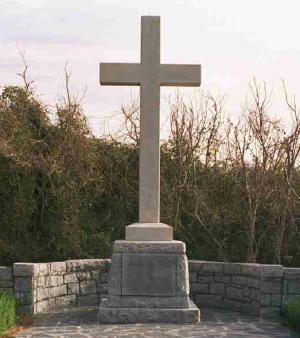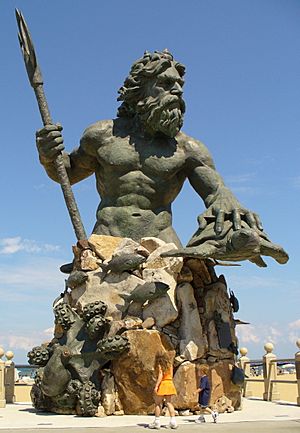History of Virginia Beach, Virginia facts for kids
The history of Virginia Beach, Virginia, goes back thousands of years to the Native Americans who lived in the area. English colonists first landed at Cape Henry in April 1607 and soon after started their first permanent settlement at Jamestown. The time when Virginia was an English colony lasted until 1776, when the American Revolution began. Since then, the area has always been part of the Commonwealth of Virginia.
Since 1634, the area we know as Virginia Beach has mostly been part of the same local government. In 1952, the resort Town of Virginia Beach became an independent city. Later, in 1963, it joined with Princess Anne County to form a new, larger independent city. They chose the name Virginia Beach because it was already well-known. Today, Virginia Beach is the biggest city in Hampton Roads, an area connected by the Hampton Roads Beltway and its large bridge-tunnels.
Contents
Native American History
Chesepians were the Native American people who lived in the area now called South Hampton Roads in Virginia. They lived there before the English settlers arrived in 1607. Their land included what is now Norfolk, Portsmouth, Chesapeake, and Virginia Beach. They had several villages, including Skicoak (in present-day Norfolk) and Apasus and Chesepioc (both near the Chesapeake Bay in Virginia Beach). Archaeologists have found many old Native American items like arrowheads, tools, and pottery in places like Great Neck Point.
The powerful Powhatan Confederacy, led by Chief Wahunsunacock, controlled much of the Chesapeake Bay area. The Chesepians spoke a similar language but were not part of Powhatan's group. In fact, they often disagreed with him.
Around 1607, when the first English settlement was founded, the Chesepians were fighting the Powhatan Confederacy. Sadly, the Chesepians faced many challenges, including conflicts and diseases brought by Europeans. By 1627, they were no longer mentioned in historical records.
Early European Arrivals

Spanish explorers sailed past the Chesapeake Bay and landed in Chincoteague in 1524. The English soon followed. In 1584, men sent by Sir Walter Raleigh explored the coast. The first English colony was started on Roanoke Island, but it mysteriously disappeared, leading to the legend of the Lost Colony.
The expedition that founded the first permanent English settlement left England on December 19, 1606. Three ships, led by Captain Christopher Newport, carried 105 men and boys. After a long journey, they first landed on April 26, 1607, at Cape Henry. This spot is in the northeastern part of today's Virginia Beach, where the Chesapeake Bay meets the Atlantic Ocean. They named it after Prince Henry, the son of King James I of England. However, the settlers soon moved further inland to find a safer place away from other European ships.
Today, the "First Landing" site is part of Joint Expeditionary Base East, a Navy base. A memorial cross and the historic Cape Henry Light are there for people to visit. First Landing State Park nearby also remembers this important event.
There was also an early settlement called Henry Town near the mouth of the Lynnhaven River. Documents from 1613 mention a fishing ship going "to Henries Towne for the reliefe of such men as were there." This suggests Henry Town was settled around the same time as Jamestown.
Forming Norfolk County
The name "Norfolk" first appeared in land records in 1637. One important person in early Virginia Beach history was Adam Thoroughgood (1604–1640). He came from Norfolk, England, and arrived in the Virginia Colony around 1622 as an indentured servant, meaning he worked for a period to pay for his trip.
After earning his freedom, Adam Thoroughgood became a respected leader. He was elected to the House of Burgesses (an early form of government) and served as a Justice of the Court. In 1634, the Virginia Colony was divided into areas called shires, which soon became "counties." Adam Thoroughgood helped name New Norfolk County in 1637, likely after his home in England.
The next year, New Norfolk County was split into Upper Norfolk County and Lower Norfolk County. Lower Norfolk County was very large, covering what are now Portsmouth, Norfolk, Chesapeake, and Virginia Beach. Adam Thoroughgood owned a lot of land along the Lynnhaven River, which was also named after a place in England. He realized Lower Norfolk County was too big and helped create a second church and court location. He passed away in 1640 at age 36.
Today, you can still see some early English settlement buildings in Virginia Beach, like the Adam Thoroughgood House museum and the Adam Keeling House.
Lower Norfolk County Splits (1638-1691)
Lower Norfolk County was so large that it needed two courthouses. Finally, in 1691, it was divided into Norfolk County and Princess Anne County. Princess Anne County was the easternmost county, stretching from the North Carolina border to Cape Henry and including all the land along the Atlantic Ocean. It was named after Princess Anne, the daughter of King James II of England. Princess Anne County existed for over 250 years, until 1963.
Kempsville's Role in the Revolution
In November 1775, Kempsville was the site of an important event during the American Revolutionary War. A man named John Ackiss was killed by soldiers loyal to the British governor, Lord Dunmore. This event, known as the "Skirmish of Kempsville," made Ackiss the first Virginian to die in the Revolutionary War.
Historic Landmarks
In 1720, Virginia's governor asked for a lighthouse to be built on Cape Henry. Work on the lighthouse was stopped by the Revolutionary War but was finally finished in 1791. In 1962, it became Virginia Beach's official symbol.
Many buildings from the Virginia colony era still stand in Virginia Beach today. These include the Adam Thoroughgood House, Old Donation Episcopal Church, and the Francis Land House.
Becoming a City (1906-1952)
Starting in the late 1800s, the small resort area of Virginia Beach began to grow, especially after 1888 when trains and electricity arrived. New hotels were built, like the Princess Anne Hotel, which opened in 1890. In 1891, guests watched the rescue of the Norwegian ship Dictator after it wrecked. The ship's figurehead later inspired the Norwegian Lady Monuments built in 1962.
The early 1900s saw many new hotels and cottages built for summer visitors. While most of these old buildings are gone, one Victorian cottage, Barclay Cottage Bed and Breakfast, still welcomes guests.
At first, people came to Virginia Beach by train and electric trolley. But in 1922, the concrete Virginia Beach Boulevard was completed, making it easy for cars and buses to reach the beach. Train service eventually stopped.
Virginia Beach officially became an incorporated town in 1906. B.P. Holland was its first mayor. After World War II, Virginia Beach grew even more, thanks to better transportation and new construction. The war also left the town with four permanent military bases: Joint Expeditionary Base East, Naval Air Station Oceana, Dam Neck Fleet Combat Training Center, and the State Military Reservation (Camp Pendleton).
In 1952, Virginia Beach became a small independent city, meaning it was politically separate from Princess Anne County. This was part of a bigger change in how cities and counties were organized in southeastern Virginia.
Joining with Princess Anne County (1963)
In 1963, the voters of Virginia Beach and Princess Anne County agreed to join together. With the approval of the Virginia General Assembly, they formed a new, much larger independent city, keeping the well-known name Virginia Beach. Around the same time, Norfolk County also joined with the small independent City of South Norfolk to form the new City of Chesapeake.
Today, most of the land that was once Princess Anne County is now part of Virginia Beach.
Challenges and Changes (1989)
In the late 1980s, many African American college students came to Virginia Beach for Labor Day Weekend, an event known as "Greekfest." In 1988, there were some problems, including reports of people taking items from a store without paying and some hotel damage.
For the 1989 Greekfest, hotels increased prices and had stricter rules, which some attendees felt were unfair and racially motivated. Also, a planned concert at the Virginia Beach Pavilion was too crowded, leading to some property damage. Because of these issues, city officials decided not to allow Greekfest to use any public facilities in 1989.
With no official events, many thousands of Greekfest attendees gathered at the oceanfront. City leaders also put new rules in place, leading to many people being stopped by police for minor issues. The Virginia National Guard was ready to help if needed. Many attendees felt unwelcome by the city.
During the 1989 event, some property damage occurred along the oceanfront. Police temporarily left the area but returned later. The next morning, about 100 stores and restaurants had been damaged. The Virginia National Guard arrived, and a state of emergency was declared. A nighttime curfew was put in place, and many attendees who were out after curfew were arrested. Some people damaged hotel property.
After these events, the city worked hard to prepare for future Greekfest weekends, spending a lot of money. They set up police checkpoints and only allowed people with special passes into the beach area. These passes were for residents, workers, and tourists with hotel reservations. Students and community leaders felt that the event had become too strict and controlled. Many African American students felt unwelcome and stopped coming to Virginia Beach for Labor Day. For many years after, Virginia Beach had difficulty attracting large numbers of African American tourists.
Future Labor Day weekends in Virginia Beach became much calmer.
The King Neptune Statue
The King Neptune statue is a famous landmark along the boardwalk in Virginia Beach. It was built to honor the Neptune Festival, a local event held every September.


